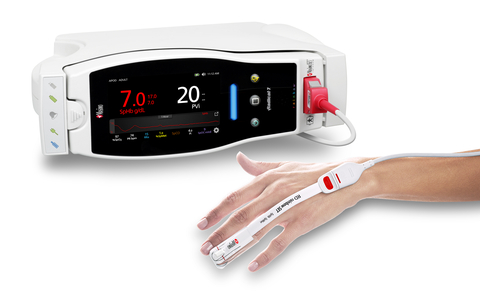NEUCHATEL, Switzerland– Masimo (NASDAQ: MASI) today announced the findings of a retrospective study published in the Journal of Clinical Monitoring and Computing in which Dr. Ayten Saracoglu and colleagues at Marmara University in Istanbul, Turkey evaluated the impact of noninvasive and continuous hemoglobin monitoring with Masimo SpHb® on perioperative transfusion management and postoperative patient outcomes on pediatric patients undergoing fronto-orbital advancement surgery. The researchers found that pediatric patients monitored with SpHb had lower intraoperative packed red blood cell (PRBC) transfusion, less postoperative bleeding, and shorter ICU stays.1
Noting the frequency of significant hemorrhage during craniofacial reconstruction surgery, and the importance of an adequate patient blood management (PBM) policy during such surgery, the researchers sought to determine whether PBM that included noninvasive and continuous hemoglobin monitoring might improve transfusion management and outcomes for children undergoing frontal advancement surgery. For their retrospective, case-control study, they collected data for 42 pediatric patients (average age 8.6 months ± 3.9 months) with plagiocephaly or trigonocephaly who underwent surgery between 2018 and 2021, dividing them into a group of 16 patients whose perioperative PBM included noninvasive, continuous hemoglobin monitoring (SpHb group), and 26 patients who were managed conventionally (control group). The SpHb group’s hemoglobin was intraoperatively monitored using SpHb on Masimo Radical-7® Pulse CO-Oximeters®.
The researchers found that patients in the SpHb group had significantly lower intraoperative PRBC transfusion (136.3 mL ± 40.1 mL vs. 181.5 mL ± 74.8 mL, p = 0.015), less postoperative surgical site drainage (125.3 mL ± 47.7 mL vs. 185.8 mL ± 97.6 mL, p = 0.013), and shorter postoperative ICU stay (37.1 hours ± 12.0 hours vs. 64.8 hours ± 24.9 hours, p < 0.001) than patients in the control group.
The investigators concluded, “SpHb measurement in pediatric craniofacial surgery for craniosynostosis is a safe, noninvasive tool to monitor Hb values and help transfusion decision-making, when used keeping in mind bias and inaccuracies of the device. Patients with continuous SpHb monitoring had decreased intraoperative PRBC transfusions, reduced postoperative surgical site bleeding, and shorter postoperative ICU stay.”
This study adds outcomes evidence for pediatric patients to the growing literature on the value of continuous hemoglobin monitoring with SpHb. In adults, SpHb, as part of PBM programs, has been found to improve outcomes in both high- and low-blood loss surgeries, such as reducing the percentage of patients receiving transfusions,2 reducing the units of red blood cells transfused per patient,3-5 reducing the time to transfusion,6 reducing costs,7 and even reducing mortality 30 and 90 days after surgery by 33% and 29%, respectively (when combined with a goal-directed fluid therapy algorithm using Masimo PVi®).8 This evidence of SpHb’s impact on outcomes spans the globe, now representing 7 countries on 4 different continents.1-8 Today, Masimo SpHb technology supports clinicians and patient care in more than 75 countries.
SpHb is not intended to replace laboratory blood testing. Clinical decisions regarding red blood cell transfusions should be based on the clinician’s judgment considering, among other factors, patient condition, continuous SpHb monitoring, and laboratory diagnostic tests using blood samples.


